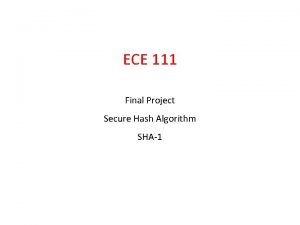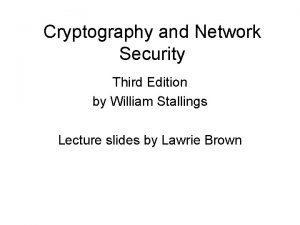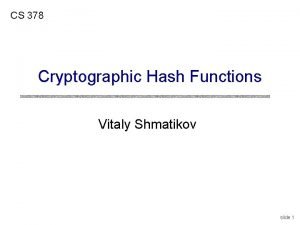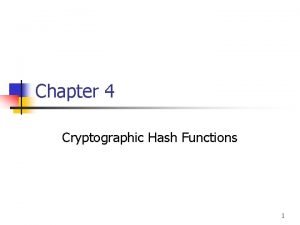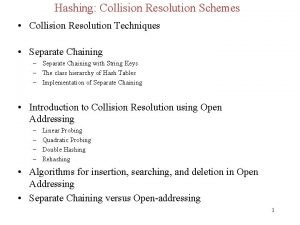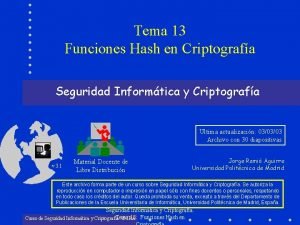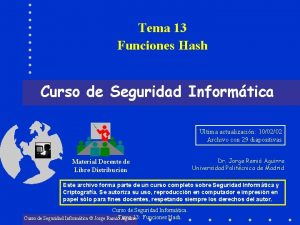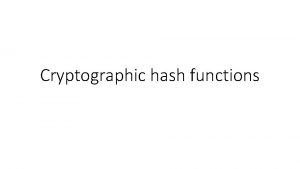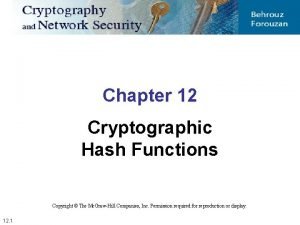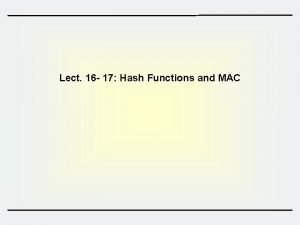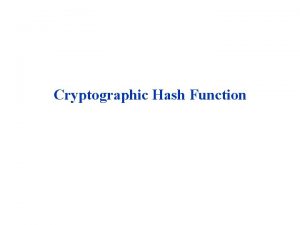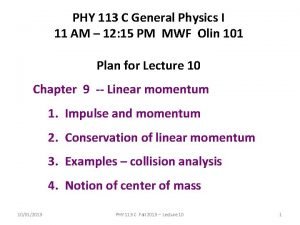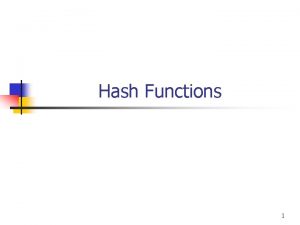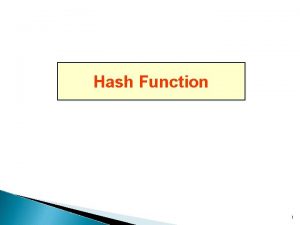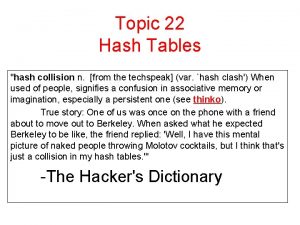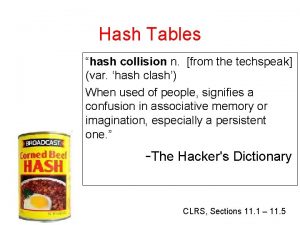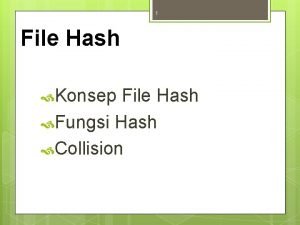Motivation Hash Functions collision preimages SHA1 Hash Functions

















- Slides: 17

- Motivation - Hash Functions: collision, pre-images - SHA-1 Hash Functions CSCI 284 Spring 2009 GWU CS 284/Spring 09/GWU/Vora/Hash Functions

The problems crypto addresses • Confidentiality/secrecy/privacy – How to keep a message secret so it can be read only by a chosen person – Use encryption • Integrity – How to determine a string of symbols has not been changed since it was created – ? 12/25/2021 CS 284/Spring 09/GWU/Vora/Hash Functions 2

Integrity • Alice sends message x to Bob. She fears Oscar will manipulate it along the way, and Bob will get an incorrect message. • She could encrypt it using a key Oscar did not have, but is that overkill when she does not need to prevent Oscar from reading it? • But maybe she could tell Bob something else about the message so he would know if something was terribly wrong: parity, last bit, a particular bit, etc. 12/25/2021 CS 284/Spring 09/GWU/Vora/Hash Functions 3

In general, she could use a hash function h: X Y y = h(x) |X| > |Y| i. e. x, x’ s. t x x’ and h(x) = h(x’) • Used in storage tables • E. g. : h(x) = last bit, parity, smallest prime factor 12/25/2021 CS 284/Spring 09/GWU/Vora/Hash Functions 4

h(x) sent with x • Both Bob and Alice can create h(x) given x • Alice sends (x, h(x)) • Bob receives (x’, y’), he checks if y’ = h(x’). • If so, he assumes x’ is what Alice sent 12/25/2021 CS 284/Spring 09/GWU/Vora/Hash Functions 5

In either case, what can the attacker do? • If he can compute h(x), he can: – try to find x’ s. t. h(x) = h(x’). • If he knows h, and can influence Alice, he can – try to get her to send an x that she likes such that h(x) = h(x’) for an x’ he likes. • If he doesn’t, he hopes for the best. 12/25/2021 CS 284/Spring 09/GWU/Vora/Hash Functions 6

Hence require an h “secure” in the following ways: • Secure wrt second image requires that the following problem is “difficult”: – Given an x X, find x’ X s. t x’ x but h(x’) = h(x) • Secure wrt collision requires that the following problem is “difficult”: – Find x, x’ X s. t x’ x but h(x’) = h(x) • The above should be true even if h(x 1), h(x 2). . h(xn) are known 12/25/2021 CS 284/Spring 09/GWU/Vora/Hash Functions 7

In general, h is a secure-hash It is also a one-way function: easy to compute in one direction, hard in the other. Is the following h secure wrt second image and collision? h: Zn X Zn h(x, y) = ax + by mod n h(x, y) = ax 2 + by 2 mod n 12/25/2021 CS 284/Spring 09/GWU/Vora/Hash Functions 8

Easy? • How does one define easy/difficult to compute? • Using computational complexity theory • By requiring a large time for the computation on any computer given a particular computational model • For example, the probabilistic polynomial-time model 12/25/2021 CS 284/Spring 09/GWU/Vora/Hash Functions 9

Algorithm Find Pre-Image(h, y, q) choose any X 0 X, | X 0 | = q for each x X 0 if h(x) = y return (x) endfor return(failure) What is the complexity of this algorithm? What is its probability of success? 12/25/2021 CS 284/Spring 09/GWU/Vora/Hash Functions 10

Algorithm Find Second Pre-Image(h, x, q) y h(x) choose any X 0 X{x}, | X 0 | = q-1 for each x 0 X 0 if h(x 0) = y return (x 0) endfor return(failure) What is the complexity of this algorithm? What is its probability of success? 12/25/2021 CS 284/Spring 09/GWU/Vora/Hash Functions 11

Algorithm Find Collision (h, q) choose any X 0 X, | X 0 | = q for each x X 0 yx h(x) endfor all pairs (x, x’) if yx = yx’ return (x, x’) endfor return(failure) 12/25/2021 CS 284/Spring 09/GWU/Vora/Hash Functions 12

Probability of success • For a lower bound, can assume that sizes of preimages are about equal, so that one pre-image is not very large - if it were, it would be very easy to have a collision in that pre-image. • M = |Y| • probability of no collisions = q-1 i=1(1 - i/M) • probability of at least one collision: (using e-x/M 1 -x/M) 1 - q-1 i=1(1 - i/M) 1 - e-q(q-1)/2 M 12/25/2021 CS 284/Spring 09/GWU/Vora/Hash Functions 13

Allowed n, q For a given acceptable collision probability p, what is q in terms of M and p? p = 1 - q-1 i=1(1 - i/M) 1 - e-q(q-1)/2 M q (2 M ln(1/1 -p)) For p = 0. 5, q 1. 17 M if M = 365, q 23 and the probability of 2 people having the same birthday in a group of 23 people is more than 0. 5 – Birthday attack/paradox 12/25/2021 CS 284/Spring 09/GWU/Vora/Hash Functions 14

Complexities/Probability of success • Find Pre-Image – Success Probability: 1 -(1 -1/M)q q/M – Complexity: (q) • Find Second Pre-Image – Success Probability: 1 -(1 -1/M)q-1 q/M – Complexity: (q) • Find Collision – Success Probability: 1 - q-1 i=1(1 - i/M) 1 - e-q(q-1)/2 M – Complexity: (q 2) 12/25/2021 CS 284/Spring 09/GWU/Vora/Hash Functions 15

SHA-1 • Pad given string x so that it is of length a multiple of 512 bits. Call this string y = M 1||M 2||…||Mn • Iteratively calculate the hash of y using a hash function (known as the compression function) for 512 bits (hash is of length 160 bits) • What is complexity of a birthday attack? 12/25/2021 CS 284/Spring 09/GWU/Vora/Hash Functions 16

SHA-1 contd. current_hash = H 0||H 1||H 2||H 3||H 4 for i=1, 2, . . n A||B||C||D||E|| = h(Mi, current_hash) H 0+=A; H 1+=B; … endfor 12/25/2021 CS 284/Spring 09/GWU/Vora/Hash Functions 17
 Sha1 algorithm steps
Sha1 algorithm steps Sha1
Sha1 Sha1
Sha1 Ordered pair and unordered pair
Ordered pair and unordered pair Hashinny
Hashinny Cryptographic
Cryptographic Collision resolution technique
Collision resolution technique Tema de hash hash
Tema de hash hash Algoritmo abcde
Algoritmo abcde Hash functions
Hash functions Davies meyer scheme
Davies meyer scheme Hash functions
Hash functions Hash functions
Hash functions Two simple hash function
Two simple hash function Collision plate margin diagram
Collision plate margin diagram Collision physics
Collision physics Tcas collision avoidance
Tcas collision avoidance Bridge collision domain
Bridge collision domain
